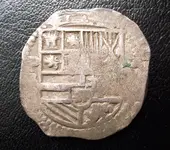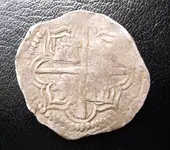B used some unusual design features that are easy to pick out between his phases. We have to consider the other B also and R. I suppose that individual minters would want to sell all the acounterments and dies in the coinhouse to the next apointee, and this was a part of their "palanca" to each other. So cutting dies might have mingled around a little on the striking die faces, and been refreshed a bit or more deeply cut.
It's almost easier to say what it is not. I would call this coin atypical. The cross goes all the way to the bendets on the back. The bottom castle is squished in. The rear lions are placed vertical. It has a very standard ticking on the rear that is leaning about 10 degrees from center. The rear bendets are very deeply cut and bold, which is unusual and it looks recut.
The front uses a crown with two types of dots on it. Portugal seems to have existed in a small shield, but is now missing. Tyrol has those inward facing vertical lines which are seen on other coins. The lions are set diagonally. The lines on the bottom left quarter are very slanted and long. The lion is of the long, horizontal type with the tail cut off by a shield line. These minters did both varieties.
I haven't found a similar die face for either side yet, and it looks kind of hard to be exactly sure of the minter. There is a B stamp die where the lower part of the letter B sticks out more than the top, helping confuse things. There are sets of dies that B and R both used that have many of these elements, while they do not have others. I will look around later and try to type it using catalogs or more pictures.







